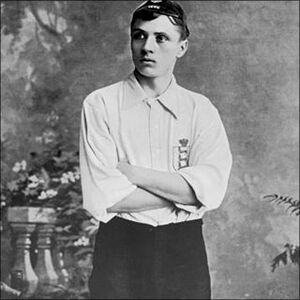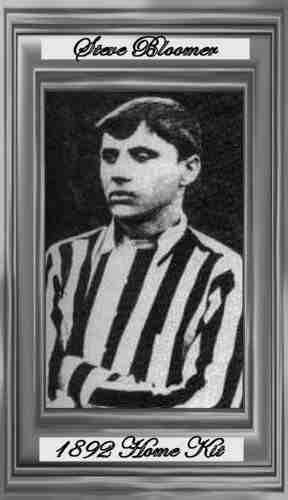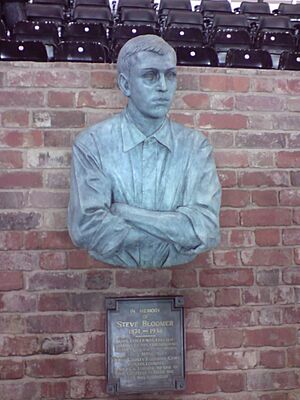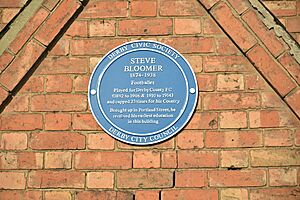Steve Bloomer facts for kids

Bloomer in England kit
|
|||
| Personal information | |||
|---|---|---|---|
| Full name | Stephen Bloomer | ||
| Date of birth | 20 January 1874 | ||
| Place of birth | Cradley, Worcestershire, England | ||
| Date of death | 16 April 1938 (aged 64) | ||
| Place of death | Derby, England | ||
| Height | 5 ft 8 in (1.73 m) | ||
| Position(s) | Forward | ||
| Youth career | |||
| 1886–1888 | St. Chad's Juniors | ||
| 1888–1891 | Derby Swifts | ||
| Senior career* | |||
| Years | Team | Apps | (Gls) |
| 1891 | Derby Midland | ||
| 1891–1906 | Derby County | 376 | (240) |
| 1906–1910 | Middlesbrough | 125 | (59) |
| 1910–1914 | Derby County | 98 | (53) |
| Total | 599 | (352) | |
| International career | |||
| 1895–1907 | England | 23 | (28) |
| Managerial career | |||
| 1914 | Britannia Berlin 92 | ||
| 1918 | Blauw-Wit Amsterdam | ||
| 1920–1922 | Derby County | ||
| 1922 | Grenadier Guards | ||
| 1922–1923 | Derby County | ||
| 1923–1925 | Real Unión | ||
| *Club domestic league appearances and goals | |||
Stephen Bloomer (born January 20, 1874 – died April 16, 1938) was a famous English footballer and manager. He played for Derby County, where he became their top goal scorer ever. He also played for Middlesbrough.
Steve Bloomer was known for scoring many goals for both his clubs and his country. He was a quick-thinking forward who could shoot powerfully and accurately with either foot. His special shot was called the daisy cutter, which was a low shot hit with great power and speed.
In 535 games in England's top football league, he scored 314 goals. Only Jimmy Greaves has scored more goals in the top English league. Bloomer also scored 28 goals in 23 games for the England national team. He helped Derby win the Second Division title in 1911–12. He also helped them finish second in the First Division in 1895–96.
The song "Steve Bloomer's Watchin'" is played at every Derby home game. There is also a statue of him at the Pride Park Stadium. He is listed in the Football League 100 Legends and the English Football Hall of Fame.
Besides football, Bloomer also played baseball for Derby Baseball Club. He helped them win the British championship three times in the 1890s. After he stopped playing football, he became a coach. He worked with clubs in Germany, the Netherlands, and Spain. During World War I, he was held in a civilian camp in Germany called Ruhleben. A highlight of his coaching career was in 1924. He led Real Unión to win the Copa del Rey, a major Spanish cup.
Contents
Early Life and Family
Steve Bloomer was born in Cradley, which is now part of the West Midlands. His parents were Caleb Bloomer, a blacksmith, and Merab Dunn. He was born on January 20, 1874, and was the oldest of six children.
When Steve was five, his family moved to Litchurch, Derbyshire. His father started working at Ley's Malleable Castings foundry in Derby. At age 12, Steve left school and became a blacksmith's apprentice. This job helped him become very strong.
Steve had a natural talent for football. He first played for St. Chad's Choir in Derby on April 11, 1887. Even though his team lost 14–0 in a final, he still played very well. His mother passed away in November 1887.
In 1888, after his 14th birthday, Steve started working at Ley's iron foundry, like his father. He also began playing football for Derby Swifts in a local league. In one game in 1890, he scored seven goals! In 1891, he played for Derby Midland in the Midland League.
Football Career
Playing for Derby County
In June 1891, Derby County joined with Derby Midland. Steve Bloomer became a Derby County player for the 1891–92 season. He first played for the club's lower teams.
He signed a professional contract with Derby County on April 28, 1892. Another club, Burton Wanderers, tried to sign him too. But the the Football Association said that contract was not valid.
Bloomer made his first team debut for Derby County in August 1892. This was because some other players were not allowed to play. He scored one goal in that game, helping Derby win 3–1. He quickly became a key player for the team. He also started taking penalty kicks. An older player, John Goodall, helped him improve his ball control and positioning.
Steve Bloomer was the top goal scorer in England's First Division five times: in 1896, 1897, 1899, 1901, and 1904. He was also Derby County's top scorer for 14 seasons in a row. He scored three goals in one game (a hat-trick) 17 times in the league! In the 1896–97 season, he scored 31 goals, including five hat-tricks. He even scored six goals in one game against Sheffield Wednesday in January 1899.
Bloomer's goals helped Derby finish second in the league in 1896. He also helped them reach three FA Cup finals in 1898, 1899, and 1903. He scored in the 1898 final, but Derby lost 3–1 to Nottingham Forest. On September 3, 1900, Bloomer scored the first-ever goal at The Hawthorns stadium.
Playing for Middlesbrough
On March 15, 1906, Bloomer moved to Middlesbrough for £750. He played alongside famous players like Alf Common. Bloomer was Middlesbrough's top scorer in the 1906–07 and 1907–08 seasons. He scored four goals in a game against Woolwich Arsenal in January 1907.
Back to Derby County
After four years at Middlesbrough, Steve Bloomer returned to Derby County in 1910. He helped them win the Second Division title in 1912. He scored his last league goal for Derby on September 6, 1913. His last game for Derby County was on January 31, 1914, when he was 40 years old.
Playing for England
Bloomer played his first game for England on March 9, 1895. He scored two goals in a 9–0 win against Ireland. This win helped England win the British Home Championship, a tournament between the UK countries.
He scored in his first 10 international games, which is still a record! He scored 19 goals in those games, including 5 goals against Wales in March 1896. He became England's all-time top goal scorer on April 2, 1898. He scored four goals against Wales again in March 1901. This made him the first player to score two hat-tricks and two four-goal games for England.
He captained England once, against Scotland in May 1902. He finished his international career in 1907 with 28 goals. He held the record for England's top scorer until Vivian Woodward broke it in 1911.
Life During World War I
Interned in Germany
After he stopped playing, Bloomer went to Germany in July 1914 to coach a team called Britannia Berlin 92. However, First World War started just three weeks after he arrived. When Britain declared war on Germany, Steve Bloomer was arrested.
On November 6, 1914, he was sent to Ruhleben. This was a camp in Berlin where civilians from enemy countries were held during the war. Many other famous footballers were also held there, including his former England teammate Sam Wolstenholme.
Football and Cricket in the Camp
The Ruhleben camp held between 4,000 and 5,500 prisoners. Over time, the prisoners created a small community. Football became very popular. They even formed the Ruhleben Football Association and organized cup and league games. Up to 1,000 people would watch the bigger matches.
In November 1914, Bloomer led a team called Tottenham Hotspur XI to win a cup final. In May 1915, an England XI team, with Bloomer, played a World XI. Bloomer also played cricket at the camp. He set a camp record by scoring 204 runs in one game. He also won a running race called the 'Old Age Handicap' at the Ruhleben Olympics.
Everyone in the camp knew Steve. When he left Ruhleben in March 1918, they held a farewell football match for him. Bloomer was sent to neutral Holland, where he coached a team called Blauw-Wit Amsterdam. He could not return home until the war ended. Bloomer later said that he and many others would not have survived the camp without football.
Coaching Career
After World War I, Bloomer coached Blauw-Wit Amsterdam in the Netherlands for a short time. He returned to England in November 1918. He became a player-coach for Derby County's reserve team. He stopped playing entirely in January 1920. In 1921, he became a coach for Derby's first team.
From May to August 1922, he coached the Grenadier Guards football team in Canada. He came back to England in August 1922 and continued coaching Derby County.
In 1923, he became the coach of Real Unión in Spain. He led them to win the 1924 Copa del Rey, a major Spanish football cup. During the 1920s, this cup was like a play-off to decide the Spanish champions. Real Unión beat strong teams like Sevilla FC, FC Barcelona, and Real Madrid to win the final.
Later Years
After coaching Real Unión, Bloomer returned to England and to Derby. He worked for the rest of his life as a groundsman and helper at the Baseball Ground, Derby County's stadium. He passed away in Derby from bronchitis, a lung illness, on April 16, 1938, at the age of 64.
Baseball Star
Steve Bloomer was also a talented baseball player. He played first base for St. James's in a local game in May 1893.
He then played baseball for Derby Baseball Club. He joined the team in May 1894, at age 20. The team reached the semi-final of the English cup in 1894. Derby Baseball Club won the English Baseball Cup on August 17, 1895, with Bloomer playing first base. They won 16 games and lost only five that season.
Derby won the English Cup again in 1897 and for a third time in 1899. In the 1899 final, Bloomer was the team captain and played second base. Derby County also formed a baseball team in 1900, which Steve Bloomer played for. This team included other Derby County football players.
His Lasting Legacy
In 2000, a plaque was put up in Cradley to remember Bloomer's birthplace. His grandson, Steve Richards, helped unveil it.
On January 17, 2009, a statue (bust) of Bloomer was put inside Pride Park, Derby. His grandsons unveiled the statue in front of his family and thousands of Derby County fans. The statue is now next to the home team's dugout at Pride Park Stadium.
Steve Bloomer is still a legend at Derby County. The club's anthem, "Steve Bloomer's Watchin'", is played and sung before every home game. He is also in the Football League 100 Legends and the English Football Hall of Fame.
On January 21, 2017, Real Unión held a "Steve Bloomer Day" to honor him. To celebrate his importance to both clubs, Real Unión and Derby County played a friendly match in Spain on October 3, 2017. This game was for the "Steve Bloomer Trophy" and is planned to happen every year.
On February 16, 2018, a Blue plaque was put on Bloomer's old school in Derby. It says:
Steve Bloomer
1874-1938
Footballer
Played for Derby County FC (1892-1914) and capped 23 times for his Country
Brought up in Portland Street, he received his earliest education in this building
See also
- List of English football first tier top scorers
- List of men's footballers with 500 or more goals




